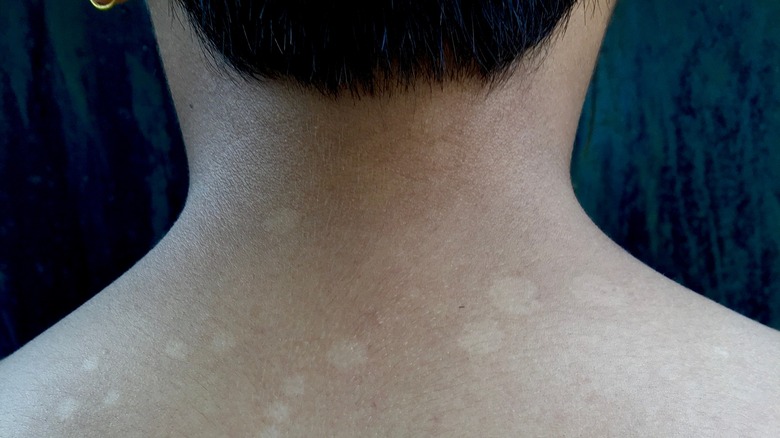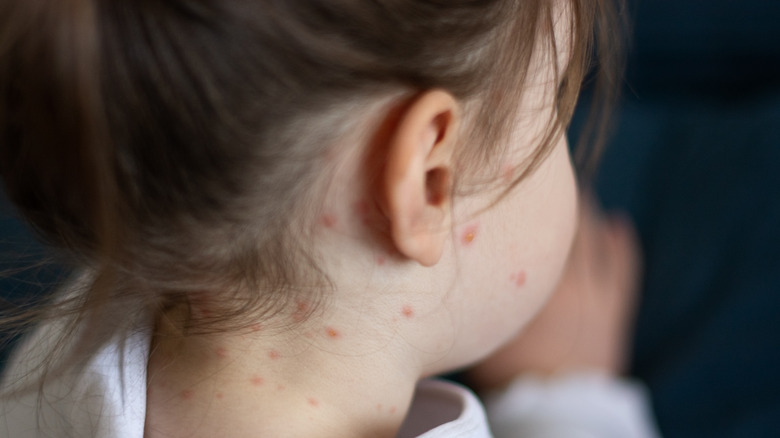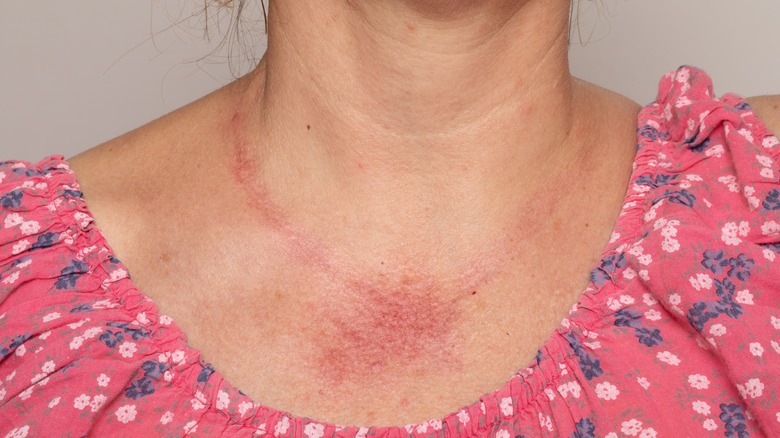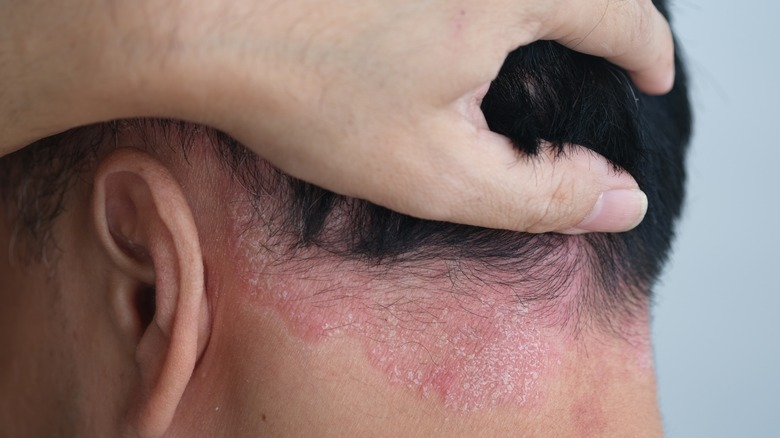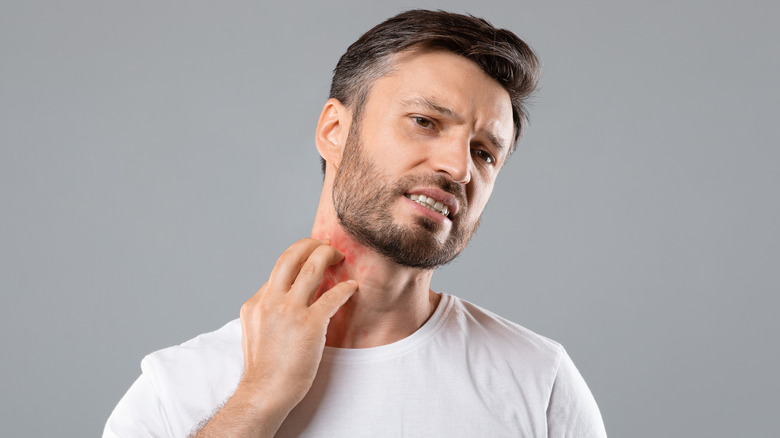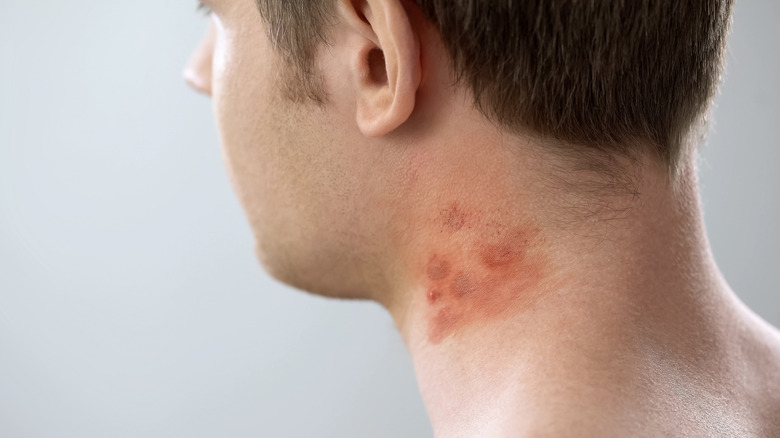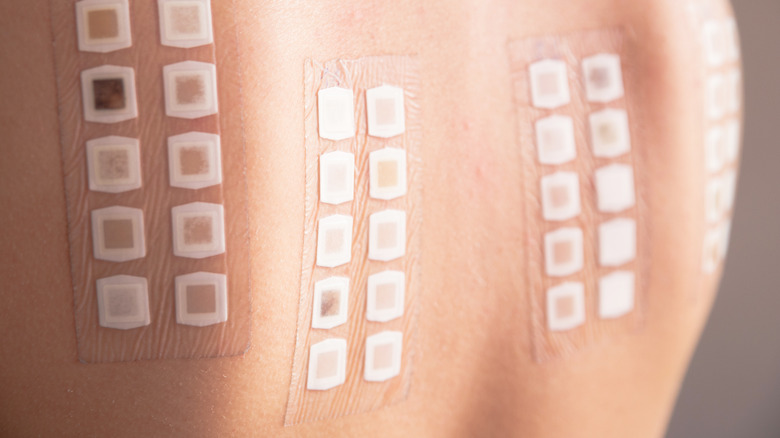How To Tell What Your Itchy, Red Rash On Your Neck Really Is
Rashes are a common symptom of various skin conditions. They're characterized by redness, inflammation, and irritation on the skin's surface and can sometimes cause pain or itchiness. They can appear in various forms and sizes, and the affected area might also feel warm to the touch and may exhibit small bumps, blisters, or patches that could ooze fluid or become scaly over time. Plus, they can affect people of all ages (via the Cleveland Clinic).
When rashes specifically occur on the neck area, they may be attributed to multiple different causes. According to Skinsight, one way to narrow down the potential cause of a skin rash is by looking not only at its location but also its extent, meaning that you should pay attention to whether it is only present around your neck or if it spreads to other parts of your body. Per MedlinePlus, common causes of neck rashes in adults include chronic skin conditions; allergic reactions that result from direct contact or friction with irritants like certain fabrics, detergents, or accessories; and underlying medical conditions. Moreover, microbial infections — such as bacteria, fungi, viruses, and parasites — as well as stress and even excessive sweating may also lead to uncomfortable neck rashes.
To determine the specific cause of a neck rash, it is crucial to seek medical evaluation from a dermatologist or qualified physician who can conduct a thorough examination and possibly perform tests. However, this article tells you what to look for to help you determine what your itchy, red rash on your neck might be.
Bacterial neck rashes
According to the New York State Department of Health, your skin is covered with different bacteria that live with you without you even noticing. But, if these bacteria get inside the body through cuts or open wounds, they can lead to skin infections that show up as a rash in the affected area.
One type of bacterial skin infection is impetigo, a mild infection caused by group A Streptococcus (although you may know it as "strep"). Per the site, an impetigo rash typically starts as itchy red sores or blisters that quickly rupture and form thick, honey-colored crusts that eventually heal without leaving any scars. Impetigo is commonly transmitted through direct skin-to-skin contact or by sharing contaminated personal items like towels or razors.
Aside from impetigo, the site lists methicillin-resistant Staphylococcus aureus (MRSA) as another common bacterial skin infection that can affect the neck area. As its name implies, MRSA is a strain of Staphylococcus aureus that has become resistant to many antibiotics, making it more challenging to treat. MRSA infections can manifest as skin rashes, mainly where there are cuts, scrapes, or other skin disruptions, and especially in areas covered by hair, like the back of the neck. The rash may appear as red, swollen, and painful sores filled with pus; and, like impetigo, it can also spread through direct contact with an infected person or by touching contaminated surfaces.
Fungal neck rashes
Fungal rashes are common skin conditions caused either by harmful fungi or fungi such as yeast, which are naturally present on your skin.
One type of neck rash caused by a fungus is tinea versicolor, which is caused by yeast overgrowth. While the fungus is virtually harmless in controlled amounts, it can become more active and overgrow, leading to infections that result in the development of the rash (via Cedars Sinai).
Tinea versicolor is characterized by the appearance of discolored patches on the skin around your upper body, including your neck, shoulders, chest, and upper back area. These patches can vary in color, ranging from lighter to darker than your usual skin color, and might be pink, red, tan, or even white. In some cases, the affected areas may flake or peel.
Per Cedars Sinai, this type of fungal rash is easier to spot during the summer because, while your skin may tan in the sun, these patches will remain a different color. Also, since the fungus thrives in warm and humid environments, the rash is more likely to appear during the hot summer months. Additionally, factors like oily skin and a weakened immune system can contribute to the fungus' growth.
Tinea versicolor can be mildly itchy or completely asymptomatic, causing no discomfort. However, this doesn't mean you shouldn't treat it once it's there. Per Cedars Sinai, this rash can be easily managed with over-the-counter antifungal creams, lotions, or shampoos. Yet, the site warns that, since it may resemble other skin conditions, you should visit a healthcare provider for the correct diagnosis and treatment plan.
Viral neck rashes
Viral infections can trigger common skin rashes that may affect your neck. Viral rashes are referred to under the umbrella term "viral exanthem."
Regarding viral exanthem, the Cleveland Clinic explains that the term refers to a widespread rash caused by a viral infection, such as measles, rubella, mononucleosis, or roseola, to mention a few. The symptoms and appearance of the rash depend on the specific virus causing it; but, generally, it looks like small red spots or raised bumps on the skin that may or may not itch. While they primarily affect your face or trunk, the neck area may be involved if the rash spreads to other body parts. In this case, lotions or creams can help relieve the discomfort.
According to Skinsight, shingles (also known as "herpes zoster") is one example of a viral rash. It is caused by the varicella-zoster virus, the same virus responsible for chickenpox. If you have had chickenpox or have been vaccinated against it, the virus remains inactive in your nerves and can reactivate later in life, leading to shingles. This rash appears as a painful cluster of blisters that wraps around one side of your chest, yet it may travel upward to your face, affecting the neck. The site states that you may fully recover within a month. Typically, antiviral medications are prescribed to reduce the severity and duration of the outbreak.
According to a 2020 review published in Dermatology, COVID-19 is a virus that has also been associated with various skin manifestations, including itchy rashes that may appear as red or purple spots. For COVID-19 rashes, low-dose corticosteroids combined with antihistamines may help control them. However, the primary focus remains on treating the infection itself.
Parasitic neck rashes
A parasitic infection is caused by parasites, which are organisms such as insects or worms that live and thrive at the expense of their host.
One type of parasitic skin rash is scabies, which is caused by tiny mites called Sarcoptes scabiei that burrow into the skin to lay eggs (via Piedmont Plastic Surgery & Dermatology). According to the Mayo Clinic, scabies is a highly contagious and itchy skin infestation that can affect people of all ages anywhere on the body, including the neck. Its symptoms typically include intense itching, especially at night. Moreover, the affected skin may develop small red bumps and tiny blisters. In some cases, scaly or crusted skin may also be observed. However, what gives this type of rash away is the formation of tiny wavy burrows or tunnels that show the path of a crawling mite (via Skinsight).
Scabies is primarily transmitted through prolonged skin-to-skin contact with an infected person, but it can also spread through sharing contaminated clothing, towels, or bedding with an infected person.
Treatment for scabies usually involves medicated creams or lotions, which effectively kill the mites and their eggs. Still, due to how easily it may spread, the site recommends that all individuals living in close contact with the infected person should also receive treatment to prevent re-infestation. Plus, washing all clothing, bedding, and towels in hot water can help eliminate any mites and prevent further spread.
Neck rashes caused by allergic reactions
Skin rashes caused by allergic reactions can affect the neck area if your neck becomes exposed to an allergen, resulting in uncomfortable symptoms.
Per Healthline, hay fever (allergic rhinitis) is an allergic reaction to airborne allergens like pollen. While it is mainly associated with respiratory symptoms, some people may experience skin rashes on the neck and other body parts due to skin contact with allergens. The rash is typically itchy, red, and swollen and may be accompanied by other well-known hay fever symptoms like sneezing, runny nose, and watery eyes.
As for poison ivy-related rashes, the American Academy of Dermatology Association (AADA) explains that this plant contains an allergen called "urushiol," which can trigger an allergic reaction upon contact with the skin. This rash appears as red, swollen, and itchy blisters, which may last from 14–21 days.
Regarding hives or urticaria, Healthline explains that this is an allergic rash characterized by raised, itchy welts on the skin that can vary in size, shape, and color depending on your skin tone. Allergic reactions to certain foods, medications, insect stings, or other allergens can cause a hives outbreak on the neck and other areas of the body. In severe cases, it can be accompanied by swelling of the face, lips, or tongue.
Lastly, gold and nickel allergies are specific types of metal allergies that can cause red, itchy, and dry rashes or blisters in your neck upon contact with jewelry or other metal-containing items (via the Mayo Clinic). However, when it comes to gold, the issue is not gold itself. Instead, this allergy happens when gold items contain trace amounts of other metals, including nickel (via Healthline).
In any of these cases, over-the-counter (OTC) antihistamines can relieve itching and inflammation.
Neck rashes caused by skin conditions
When noticing a skin rash, it is almost automatic to think of infections or allergies. Yet, you should also keep in mind that skin conditions, such as heat rash and psoriasis, can affect the neck area, leading to discomfort and irritation.
According to Healthline, heat rash is a common skin condition that occurs when sweat ducts become blocked, trapping sweat beneath the skin. Therefore, it is more common in hot and humid climates and on sweat-prone body parts like your neck. In addition, overheating, excessive sweating, and wearing tight or non-breathable clothing can develop heat rash in the neck area.
There are different types of heat rash, yet the itchy kind is called "miliaria rubra" (also known as "prickly heat"), which appears as small red bumps or blisters and is accompanied by a prickling sensation (hence the name). Per the site, while heat rash usually goes away on its own, treatments may involve keeping the skin cool and dry, avoiding tight clothing, and using over-the-counter creams or ointments to alleviate the itching.
On the other hand, the Mayo Clinic explains that psoriasis is a chronic autoimmune skin condition that leads to a rapid buildup of skin cells. This happens because your immune system causes the cells to grow faster than your body can handle, resulting in dry, scaly, and inflamed patches. Like heat rash, there are multiple types of psoriasis that look different and affect different parts of your body. Still, the site describes them as creating dandruff-like scaling or rashes that may go from purplish-gray to reddish-silver, depending on your skin tone.
When it comes to treating psoriasis, treatment options depend on its severity and may include medicated creams that are applied directly to the skin, light therapy, or oral or injected medications.
Stress rash
According to Medical News Today, a stress rash (also known as "stress hives") is a physical skin condition triggered by emotional or psychological stress, and the neck is one of the common sites where stress rashes can appear. Per the site, stress hives are believed to result from chemical imbalances in response to stress, causing blood vessels to leak and leading to the formation of the rash. Plus, it can appear suddenly in response to stressful situations or prolonged periods of stress. Moreover, the immune system's reaction to stress can also make the skin more sensitive and prone to developing rashes and worsen other rash-related skin conditions, such as psoriasis.
Symptoms of a stress rash on the neck typically include red, raised bumps or clusters that are itchy and may be accompanied by a burning or stinging sensation. The rash may also vary in size and shape (via U.S. News & World Report).
Managing stress is essential in preventing and alleviating stress rashes, so practicing techniques such as relaxation exercises, meditation, yoga, and deep breathing can help reduce stress levels. Also, getting enough sleep, regular exercise, and eating a balanced diet contribute to stress reduction and skin health. Per the site, while addressing the root cause of stress is crucial for long-term management, OTC antihistamines help relieve the itching and inflammation from a stress rash.
Neck rashes caused by medical conditions
Believe it or not, some medical conditions that have nothing to do with your skin may lead to skin manifestations in different body parts, including your neck. For example, Kawasaki disease is a rare but serious condition that mainly affects children. It is characterized by inflammation of blood vessels all over the body, including the skin. A rash — often on the neck and trunk — appears as red, swollen, and peeling skin. Other symptoms may include fever, swollen lymph nodes, red eyes, and cracked lips (via Healthgrades).
Another medical condition that can impact your skin is systemic lupus erythematosus (SLE), commonly known as "lupus." Per the Centers for Disease Control and Prevention (CDC), SLE is an autoimmune disease in which the immune system attacks healthy tissues, including the skin. A characteristic lupus rash or butterfly rash can appear on the cheeks and bridge of the nose, sometimes extending to the neck area (via the CDC).
Lastly, neurodermatitis (lichen simplex chronicus is a common form) is a chronic condition characterized by intense itching and thick, scaly, leathery patches of skin. It can affect any part of the body, including the back of the neck, and is often triggered or worsened by stress and psychological factors (via the Cleveland Clinic).
When it comes to treating rashes caused by these medical conditions, the focus typically centers on addressing the underlying cause.
Contact dermatitis
Contact dermatitis (CD) is a common skin condition characterized by redness, itching, and inflammation that occurs when the skin interacts with certain substances known as skin irritants. Generally speaking, CD is classified as allergic or irritant, depending on whether you come in contact with a substance you're allergic to or a toxic material, respectively (via Healthline). Per the site, a rash from allergic CD is itchy, flaky, and bumpy and may go from red to purple. You may also notice leaky blisters and a burning sensation around the area. In contrast, irritant CD typically shows up as a dry, stiff, and swollen rash with open sores.
Per the U.S. Food & Drug Administration (FDA), common causes of allergic CD that may affect the neck are fragrances, preservatives, and other chemicals commonly found in cosmetics, which can trigger the immune system's response, leading to the rash. On the other hand, detergents and cleaning products typically cause irritant CD, as the harsh chemicals in these products can irritate and sensitize the neck area, leading to a rash when they come into contact with the skin. This can happen either the first time you're exposed to them or after repeatedly using them over time (via Healthline). Furthermore, clothing can also be a source of CD, which is known as "textile dermatitis." Per WebMD, your clothes may lead to an itchy rash where the fabric comes into contact with the skin when made from certain synthetic materials like nylon or polyester or when treated with chemicals like dyes or resins.
Preventing CD on the neck involves identifying and avoiding the specific triggers, and its treatment usually relies on anti-itch creams or lotions (via Healthline).
Neck rash diagnosis
Diagnosing skin rashes often requires specific tests to determine the underlying cause and guide appropriate treatment. Per MedlinePlus, three standard diagnostic tests for skin rashes are patch tests, blood tests, and biopsies, which go from least to most invasive.
Patch tests help determine the specific substances triggering the allergic response and are used to identify allergic contact dermatitis. Small amounts of potential allergy-causing substances are applied to adhesive patches, which are then placed on your skin. After a couple of days, the patches are removed, and the skin is examined for any signs of irritation or allergic reactions.
As for blood tests, the Cleveland Clinic explains they are a simple and quick way to check for specific antibodies called immunoglobulin E (IgE) in your blood. These antibodies are produced by your immune system when foreign and dangerous substances like viruses or bacteria enter your body. However, in the case of allergies, your body may mistakenly produce IgE in response to harmless substances, too. Since there are plenty of potential causes for a neck rash (both allergic and non-allergic), running blood labs is an easy way to get an accurate diagnosis (via Skinterrupt).
Lastly, biopsies involve the removal of a small sample of affected skin for laboratory analysis to help identify specific changes in the skin's structure, cells, or inflammation patterns. This test is particularly valuable when diagnosing complex or rare skin conditions (via DermNet).
Based on the results of these tests, your healthcare provider will be able to create a tailored treatment plan to manage your neck rash effectively.
Preventing and treating a neck rash
Preventing itchy neck rashes involves adopting good hygiene practices and making choices that minimize exposure to potential irritants. According to the National Eczema Association, keeping the neck area clean and dry helps remove dirt, sweat, and oil that can contribute to rashes. Also, moisturizing regularly and wearing sunscreen to protect against sunburns will contribute to preserving your skin barrier, which is essential for skin health. Lastly, choosing hypoallergenic skin care products, fragrance-free detergents, and lightweight clothing made from breathable materials helps reduce the risk of skin irritation and allergic reactions on the neck (via News in Health).
As for treatment options, Medical News Today mentions that applying a cold, damp cloth around the neck, taking a lukewarm oatmeal bath, applying aloe vera gel or calamine lotion, and using a humidifier to prevent getting dry skin are common home remedies that help reduce itching and inflammation. However, severe or persistent neck rashes may call for pharmaceutical treatment options, such as OTC or prescription-strength corticosteroids or antihistamines, phototherapy (light therapy), or medications to treat underlying conditions. Keep in mind that it's essential to seek medical advice if the rash worsens, spreads, or causes significant discomfort to receive a proper diagnosis and appropriate treatment.



